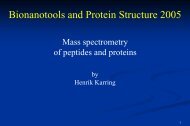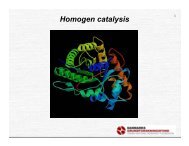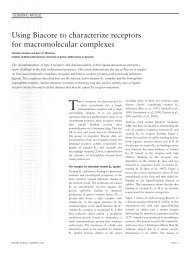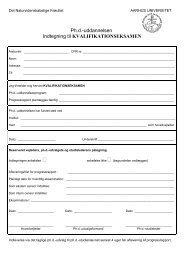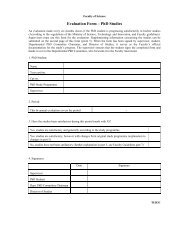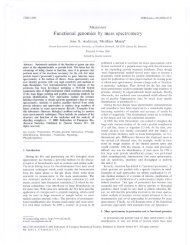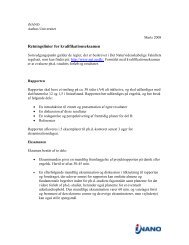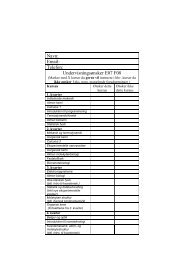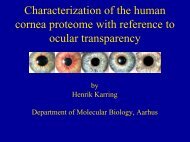Expression, refolding, and purification of recombinant human ...
Expression, refolding, and purification of recombinant human ...
Expression, refolding, and purification of recombinant human ...
You also want an ePaper? Increase the reach of your titles
YUMPU automatically turns print PDFs into web optimized ePapers that Google loves.
Protein <strong>Expression</strong> <strong>and</strong> PuriWcation 39 (2005) 18–26<br />
www.elsevier.com/locate/yprep<br />
<strong>Expression</strong>, <strong>refolding</strong>, <strong>and</strong> puriWcation <strong>of</strong> <strong>recombinant</strong><br />
<strong>human</strong> granzyme B<br />
Rikke H. Lorentsen a,b,¤ , Charlotte H. Fynbo a,b , Hans C. Thøgersen a,b ,<br />
Michael Etzerodt a,b , Thor L. Holtet b<br />
a<br />
Department <strong>of</strong> Molecular Biology, University <strong>of</strong> Aarhus, Gustav Wieds Vej 10, DK-8000 Aarhus C, Denmark<br />
b<br />
Borean Pharma A/S, Science Park Aarhus, Gustav Wieds Vej 10, DK-8000 Aarhus C, Denmark<br />
Received 18 May 2004, <strong>and</strong> in revised form 14 August 2004<br />
Abstract<br />
Granzyme B (GrB) is a member <strong>of</strong> a family <strong>of</strong> serine proteases involved in cytotoxic T-lymphocyte-mediated killing <strong>of</strong> potentially<br />
harmful cells, where GrB induces apoptosis by cleavage <strong>of</strong> a limited number <strong>of</strong> substrates. To investigate the suitability <strong>of</strong> GrB as an<br />
enzyme for speciWc fusion protein cleavage, two derivatives <strong>of</strong> <strong>human</strong> GrB, one dependent on blood coagulation factor X a (FX a )<br />
cleavage for activation <strong>and</strong> one engineered to be self-activating, were <strong>recombinant</strong>ly expressed in Escherichia coli. Both derivatives<br />
contain a hexa-histidine aYnity tag fused to the C-terminus <strong>and</strong> expressed as inclusion bodies. These were isolated <strong>and</strong> solubilized in<br />
guanidiniumHCl, immobilized on a Ni 2+ –NTA agarose column, <strong>and</strong> refolded by application <strong>of</strong> a cyclic <strong>refolding</strong> protocol. The<br />
refolded pro-rGrB-H6 could be converted to a fully active form by cleavage with FX a or, for pro(IEPD)-rGrB-H6, by autocatalytic<br />
processing during the Wnal puriWcation step. A self-activating derivative in which the unpaired cysteine <strong>of</strong> <strong>human</strong> GrB was substituted<br />
with phenylalanine was also prepared. Both rGrB-H6 <strong>and</strong> the C228F mutant were found to be highly speciWc <strong>and</strong> eYcient processing<br />
enzymes for the cleavage <strong>of</strong> fusion proteins, as demonstrated by cleavage <strong>of</strong> fusion proteins containing the IEPD recognition<br />
sequence <strong>of</strong> GrB.<br />
© 2004 Elsevier Inc. All rights reserved.<br />
Keywords: Granzyme B<br />
Recombinant production <strong>of</strong> proteins with favourable<br />
properties, both for research <strong>and</strong> pharmaceutical applications,<br />
is frequently accomplished through production<br />
<strong>of</strong> fusion proteins, in which the target protein is linked to<br />
a fusion partner that may stimulate the expression,<br />
increase the stability, or facilitate aYnity puriWcation <strong>of</strong><br />
the fusion protein. However, the fusion partner may<br />
introduce undesirable changes in the biological activity<br />
or increase the immunogenicity <strong>of</strong> the protein <strong>of</strong> interest<br />
<strong>and</strong>, therefore, it is necessary to separate the fusion<br />
partner from the protein <strong>of</strong> interest after expression <strong>and</strong><br />
* Corresponding author. Fax: +45 86246850.<br />
E-mail address: rhl@boreanpharma.com (R.H. Lorentsen).<br />
puriWcation to get the target protein in authentic form.<br />
Presently, this processing is accomplished by designing<br />
fusion proteins with cleavage sites that allow speciWc<br />
enzymatic or chemical cleavage. Highly speciWc proteases<br />
isolated from mammalian sources, such as bovine blood<br />
coagulation factor X a (FX a ), are frequently used for<br />
enzymatic cleavage <strong>of</strong> fusion proteins. They are particularly<br />
suitable for that purpose, as they recognize a<br />
sequence <strong>of</strong> amino acid residues instead <strong>of</strong> only one residue,<br />
which decreases the probability <strong>of</strong> non-speciWc<br />
cleavage in a site not intended. However, isolation <strong>of</strong><br />
these proteases is costly, <strong>and</strong> the risk <strong>of</strong> pathogenic contamination<br />
when cleaving proteins for therapeutic applications<br />
prohibits the use <strong>of</strong> these processing enzymes in<br />
<strong>recombinant</strong> production <strong>of</strong> pharmaceutical proteins. The<br />
1046-5928/$ - see front matter © 2004 Elsevier Inc. All rights reserved.<br />
doi:10.1016/j.pep.2004.08.017
R.H. Lorentsen et al. / Protein <strong>Expression</strong> <strong>and</strong> PuriWcation 39 (2005) 18–26 19<br />
objective <strong>of</strong> the investigations presented in this paper is<br />
to generate a protease, which can be produced on a large<br />
scale in a bacterial host <strong>and</strong> with advantage, be used for<br />
speciWc <strong>and</strong> eYcient processing <strong>of</strong> fusion proteins.<br />
Cytoplasmic granules <strong>of</strong> cytotoxic T-lymphocytes<br />
contain a family <strong>of</strong> serine proteases termed granzymes.<br />
In combination with the pore-forming protein, perforin,<br />
they play critical roles in events that culminate in the<br />
death <strong>of</strong> virus-infected <strong>and</strong> other potentially harmful<br />
cells [1]. Granzyme B (GrB) is one member <strong>of</strong> this protease<br />
family <strong>and</strong> is believed to induce apoptosis <strong>of</strong> abnormal<br />
cells by cleavage <strong>and</strong> activation <strong>of</strong> caspases,<br />
including caspase-3 <strong>and</strong> -8. In addition, GrB can initiate<br />
caspase-independent pathways <strong>of</strong> cell death by cleaving<br />
various other cellular substrates [2]. The inactive zymogen<br />
form <strong>of</strong> GrB is equipped with an N-terminal activation<br />
dipeptide that is cleaved oV by dipeptidyl peptidase<br />
I (DPPI) at the time <strong>of</strong> packaging into cytotoxic granules,<br />
providing storage <strong>of</strong> the single-chain active serine<br />
protease [1,3]. GrB exhibits the unique speciWcity among<br />
mammalian serine proteases to cleave substrate peptide<br />
bonds after aspartic acid residues <strong>and</strong> requires extended<br />
enzyme–substrate binding interactions for eYcient catalysis,<br />
consistent with its role as a regulative, rather than a<br />
degradative, enzyme [1,4]. By a combinatorial approach<br />
the tetrapeptide sequence IEPD has been identiWed as<br />
the preferred P4–P1 recognition motif <strong>of</strong> GrB for small<br />
peptide substrates, although optimal substrate recognition<br />
may involve features beyond this tetrapeptide<br />
sequence [5,6]. The crystal structure <strong>of</strong> rat <strong>and</strong> <strong>human</strong><br />
GrB was recently determined <strong>and</strong> provides some rationale<br />
for the substrate speciWcity [7–9]. The three-dimensional<br />
structure is generally similar to that <strong>of</strong> the trypsin-family<br />
serine proteases, although pr<strong>of</strong>ound diVerences in the S1<br />
site account for the strict requirement <strong>of</strong> GrB for aspartic<br />
acid in the P1 position. The high speciWcity by which<br />
GrB apparently cleaves a limited number <strong>of</strong> substrates<br />
suggests that it would be suitable as a processing<br />
enzyme, provided it could be produced in high yields by<br />
<strong>recombinant</strong> methods in prokaryotes or other microbiological<br />
host systems. Recombinant granzymes, including<br />
granzyme A, B, <strong>and</strong> K, have been produced in various<br />
prokaryotic <strong>and</strong> eukaryotic host systems as active<br />
enzymes or inactive zymogens for the purpose <strong>of</strong> structural,<br />
functional, <strong>and</strong> biochemical characterization<br />
[6,10–17]. Recently, production <strong>of</strong> <strong>recombinant</strong> <strong>human</strong><br />
granzyme K from Escherichia coli inclusion bodies by<br />
subsequent <strong>refolding</strong> <strong>and</strong> activation was reported [18].<br />
In this paper, we describe the production <strong>of</strong> <strong>recombinant</strong><br />
<strong>human</strong> GrB, both as a derivative dependent on FX a<br />
cleavage for activation <strong>and</strong> a self-activating derivative.<br />
The activated <strong>recombinant</strong> enzyme can be produced in<br />
high yield, <strong>and</strong> is shown to cleave fusion proteins containing<br />
the IEPD recognition sequence with a high degree<br />
<strong>of</strong> speciWcity <strong>and</strong> eYciency, making it an ideal reagent for<br />
the processing <strong>of</strong> <strong>recombinant</strong> pharmaceutical products.<br />
Methods <strong>and</strong> materials<br />
Construction <strong>of</strong> the pT7-rGrB-H6, pT7-IEPD-rGrB-H6,<br />
<strong>and</strong> position 228 variants expression vectors<br />
The pT7-C-term-H6 vector was prepared by ligation<br />
<strong>of</strong> the annealed oligonucleotides 5-CATGGACGG<br />
AAGCTTGAATTCACATCACCATCACCATCACTA<br />
ACGC-3 <strong>and</strong> 5-AATTGCGTTAGTGATGGTGAT<br />
GGTGATGTGAATTCAAGCTTCCGTC-3 into the<br />
NcoI <strong>and</strong> EcoRI cloning site <strong>of</strong> the pT7 expression vector<br />
[19]. The DNA sequence encoding the mature <strong>human</strong><br />
GrB (EC-nr.: 3.4.21.79) from Ile21 (Ile16 in chymotrypsinogen<br />
numbering) to Tyr247 was ampliWed by PCR<br />
from a mixture <strong>of</strong> cDNA isolated from <strong>human</strong> bone<br />
marrow, <strong>human</strong> leukocytes, <strong>human</strong> lymph nodes, <strong>and</strong><br />
lymphoma (Raji) cells (Clontech Laboratories) using the<br />
following primers: 5CATGGGATCCATCGAGGGT<br />
AGGATCATCGGGGGACATGAG-3 <strong>and</strong> 5-GCGT<br />
GAATTCAGGTACCGTTTCATGGTTTTCTTTATC<br />
C-3. The PCR product was digested with BamHI <strong>and</strong><br />
EcoRI, <strong>and</strong> ligated into the corresponding sites <strong>of</strong> the<br />
pT7-C-term-H6 expression vector, resulting in the pT7-<br />
rGrB-H6 expression vector. The pT7-IEPD-rGrB-H6<br />
expression vector was constructed by using the Quik-<br />
Change Site-directed Mutagenesis Kit (Stratagene) with<br />
pT7-rGrB-H6 as template <strong>and</strong> the following mutagenesis<br />
primers: 5-TCCATCGAGCCGGATATCATC<br />
GGGGGACATGAG-3 <strong>and</strong> 5-CCCCGATGATAT<br />
CCGGCTCGATGGATCCCATATG-3. Substitution <strong>of</strong><br />
cysteine 228 (chymotrypsinogen numbering) in pT7-<br />
IEPD-rGrB-H6 with alanine, serine, threonine, valine, or<br />
phenylalanine was also performed by using the sitedirected<br />
mutagenesis kit <strong>and</strong> the mutagenesis primers<br />
5-TCCACGAGCCDCCACCAAAGTCTCAAG-3<br />
(DDA, G, or T) <strong>and</strong> 5-AGACTTTGGTGGHGGCTC<br />
GTGGAGGC-3 (H D A, C, or T) to create the pT7-<br />
IEPD-rGrB-H6-C228A, -C228S, <strong>and</strong> -C228T, respectively,<br />
or 5-TCCACGAGCCKTCACCAAAGTCTCA<br />
AG-3 (K D G or T) <strong>and</strong> 5-AGACTTTGGTGAMG<br />
GCTCGTGGAGGC-3 (M D A or C) to create pT7-<br />
IEPD-rGrB-H6-C228V <strong>and</strong> -C228F, respectively. All<br />
primers <strong>and</strong> oligonucleotides were purchased from<br />
DNA Technology A/S. All sequences <strong>and</strong> mutations<br />
were veriWed by nucleotide sequencing using the BigDye<br />
Terminator version 3.0 DNA sequencing Kit (Applied<br />
Biosystems).<br />
<strong>Expression</strong> <strong>and</strong> puriWcation <strong>of</strong> <strong>recombinant</strong> pro-rGrB-H6<br />
Single colonies <strong>of</strong> E. coli BL21 cells transformed with<br />
the pT7-rGrB-H6 expression vector were used to inoculate<br />
100 mL <strong>of</strong> 2£ TY medium containing 100 mg/L<br />
ampicillin. After overnight growth, 30 mL <strong>of</strong> this culture<br />
was transferred to 1 L <strong>of</strong> 2£ TY medium containing<br />
100 mg/L ampicillin <strong>and</strong> grown at 37 °C with shaking
20 R.H. Lorentsen et al. / Protein <strong>Expression</strong> <strong>and</strong> PuriWcation 39 (2005) 18–26<br />
until OD 600 D 0.7–0.8. <strong>Expression</strong> was induced by infection<br />
with bacteriophage λCE6 at a multiplicity <strong>of</strong><br />
approximately 5, <strong>and</strong> incubation was continued for<br />
another 4 h before the cells were harvested by centrifugation.<br />
The cell pellet from 3 L <strong>of</strong> culture was resuspended<br />
in 100 mL <strong>of</strong> lysis buVer containing 50 mM Tris–HCl,<br />
pH 8.0, 25% (w/v) sucrose, 1 mM EDTA before addition<br />
<strong>of</strong> lysozyme (Sigma) to a Wnal concentration <strong>of</strong> 1 mg/mL<br />
<strong>and</strong> incubation at room temperature for 15 min. 200 mL<br />
detergent buVer containing 0.2 M NaCl, 1% (w/v) deoxycholic<br />
acid, 1% (w/v) nonidet P-40, 20 mM Tris–HCl, pH<br />
7.5, 2 mM EDTA was added <strong>and</strong> the preparation was<br />
gently homogenized before the inclusion bodies were<br />
collected by centrifugation. The inclusion bodies were<br />
washed at least three times with 50 mL <strong>of</strong> a buVer containing<br />
0.5% (w/v) Triton X-100, 1 mM EDTA before<br />
they were solubilized in a buVer containing 6 M guanidinium·HCl,<br />
50 mM Tris–HCl, pH 8.0, 100 mM dithiothreitol.<br />
The crude protein preparation was gel Wltrated into<br />
a buVer containing 8 M urea, 0.5 M NaCl, 50 mM Tris–<br />
HCl, pH 8.0, 5 mM 2-mercaptoethanol before it was<br />
batch-mixed with Ni 2+ –NTA agarose (Qiagen) for 5 min<br />
<strong>and</strong> packed into a column (2.6 £ 10 cm, Amersham Biosciences).<br />
The pro-rGrB-H6 fusion protein was puriWed<br />
from the majority <strong>of</strong> E. coli <strong>and</strong> λ-phage proteins by<br />
washing with one column volume <strong>of</strong> loading buVer containing<br />
8 M urea, 0.5 M NaCl, 50 mM Tris–HCl, pH 8.0,<br />
5 mM 2-mercaptoethanol followed by one-column volume<br />
<strong>of</strong> a buVer containing 6 M guanidinium·HCl,<br />
50 mM Tris–HCl, pH 8.0, 5 mM 2-mercaptoethanol <strong>and</strong>,<br />
Wnally, loading buVer until a stable baseline was reached.<br />
Bound pro-rGrB-H6 was either eluted in loading buVer<br />
supplemented with 10 mM EDTA to check the purity by<br />
SDS–PAGE or applied to <strong>refolding</strong> after washing with a<br />
buVer containing 8 M urea, 0.5 M NaCl, 50 mM Tris–<br />
HCl, pH 8.0, 3 mM reduced glutathione.<br />
Refolding <strong>and</strong> Wnal puriWcation <strong>of</strong> pro-rGrB-H6<br />
Over a 24-h period the column with bound pro-rGrB-<br />
H6 was applied to a cyclic <strong>refolding</strong> protocol described<br />
in [20]. In brief, each cycle started with 45 min <strong>of</strong> renaturation,<br />
followed by a step <strong>of</strong> denaturing <strong>and</strong> reducing<br />
conditions for 6 min, followed by a linear gradient <strong>of</strong><br />
8 min from denaturation to renaturation <strong>and</strong> the start <strong>of</strong><br />
the next cycle with 45 min <strong>of</strong> renaturation. The buVer<br />
applied for renaturation contained 0.5 M NaCl, 50 mM<br />
Tris–HCl, pH 8.0, 2 mM reduced glutathione, 0.2 mM<br />
oxidized glutathione, while the buVer applied in the<br />
denaturing phases was mixed from the renaturation<br />
buVer <strong>and</strong> a denaturation buVer containing 6 M urea,<br />
0.5 M NaCl, 50 mM Tris–HCl, pH 8.0, 3 mM reduced<br />
glutathione. The percentage <strong>of</strong> denaturation buVer was<br />
decreased in steps from 100% in cycle one to 35% in<br />
cycle 23 before the procedure was completed with 45 min<br />
<strong>of</strong> renaturation. The <strong>refolding</strong> was performed at a Xow<br />
rate <strong>of</strong> 2 mL/min <strong>and</strong> at 10 °C. After completion <strong>of</strong> the<br />
<strong>refolding</strong> protocol, the column was washed with twocolumn<br />
volumes <strong>of</strong> buVer containing 0.5 M NaCl,<br />
50 mM Tris–HCl, pH 8.0, before the refolded pro-rGrB-<br />
H6 was eluted in that buVer supplemented with 10 mM<br />
EDTA. The pooled sample was diluted with one volume<br />
<strong>of</strong> 50 mM Tris–HCl, pH 7.0, <strong>and</strong> the pH was adjusted to<br />
pH 7.0. by dropwise addition <strong>of</strong> 0.5 M HCl before the<br />
protein solution was loaded onto a SP Sepharose ionexchange<br />
column (1 £ 10 cm, Amersham Biosciences)<br />
pre-equilibrated in running buVer containing 250 mM<br />
NaCl, 50 mM Tris–HCl, pH 7.0. The protein was<br />
fractionated by elution with a linear gradient from<br />
250 mM to 1 M NaCl in 50 mM Tris–HCl, pH 7.0 at<br />
room temperature. Samples from the elution proWle were<br />
analyzed by non-reducing SDS–PAGE <strong>and</strong> the enzymatic<br />
activity was measured as described below. The<br />
peak fractions were pooled <strong>and</strong> the concentration <strong>of</strong><br />
pro-rGrB-H6 was estimated by absorption at 280 nm<br />
<strong>and</strong> the assumption that A(1%) 280 for pro-rGrB-H6 is<br />
1g L ¡1 cm ¡1 .<br />
Activation <strong>of</strong> pro-rGrB-H6<br />
A sample <strong>of</strong> the pooled protein was directly used for<br />
activation processing by FX a . Approximately 0.15 mg <strong>of</strong><br />
pro-rGrB-H6 in 1.5 mL was activated by the addition <strong>of</strong><br />
1.5 μg <strong>of</strong> native bovine FX a (Borean Pharma A/S) <strong>and</strong><br />
incubation at room temperature. Five-microliter aliquots<br />
were withdrawn after 0, 1, 2, 5, 24, 48, 75, <strong>and</strong><br />
120 h <strong>of</strong> incubation <strong>and</strong> immediately used to measure the<br />
enzymatic activity as described below. The contribution<br />
from the FX a to the hydrolysis rate <strong>of</strong> the Ac-IEPDpNA<br />
substrate was measured <strong>and</strong> found to be zero.<br />
After 120 h <strong>of</strong> incubation, FX a was removed by dilution<br />
<strong>of</strong> the protein sample with two volumes <strong>of</strong> 50 mM<br />
Tris–HCl, pH 7.0, <strong>and</strong> loading onto an SP Sepharose<br />
ion-exchange column (1 £ 5 cm, Amersham Biosciences)<br />
pre-equilibrated in running buVer containing 250 mM<br />
NaCl, 50 mM Tris–HCl, pH 7.0. The column was<br />
intensively washed with the running buVer to remove<br />
the FX a before bound rGrB-H6 was eluted in one step<br />
with buVer containing 750 mM NaCl, 50 mM Tris–HCl,<br />
pH 7.0.<br />
Activity assay<br />
Enzymatic activity was measured as the initial rate <strong>of</strong><br />
hydrolysis <strong>of</strong> the Ac-IEPD-pNA (Calbiochem) substrate<br />
by monitoring the increase <strong>of</strong> A 405 nm over time using a<br />
Varian Cary 50 Bio UV–Visible spectrophotometer.<br />
Five-microliter aliquots <strong>of</strong> enzyme were added to reaction<br />
mixture containing 400 μM substrate, 0.1 M Hepes,<br />
pH 7.75, in a total volume <strong>of</strong> 500 μL. A 100 mM substrate<br />
stock solution was prepared in 99.7% DMSO <strong>and</strong><br />
stored at ¡20 °C.
R.H. Lorentsen et al. / Protein <strong>Expression</strong> <strong>and</strong> PuriWcation 39 (2005) 18–26 21<br />
Preparation <strong>of</strong> self-activating rGrB-H6 derivative<br />
Conditions <strong>of</strong> expression, <strong>refolding</strong>, <strong>and</strong> puriWcation<br />
<strong>of</strong> the pro(IEPD)-rGrB-H6 variant were identical to<br />
those described for the pro-rGrB-H6 enzyme. The enzymatic<br />
activity <strong>of</strong> a sample <strong>of</strong> the pooled refolded protein,<br />
withdrawn before the protein was loaded onto the SP<br />
Sepharose ion-exchange column <strong>and</strong> <strong>of</strong> the pooled protein<br />
after elution from the SP Sepharose ion-exchange<br />
column was measured as described above. The preparation<br />
procedure was repeated, <strong>and</strong> for complete autocatalytic<br />
activation, the ion-exchange column was washed<br />
with 250 mM NaCl, 50 mM Tris–HCl, pH 7.0, for 4 h,<br />
before the protein was eluted following the procedure<br />
described for pro-rGrB-H6.<br />
Preparation <strong>of</strong> rGrB-H6 variants in position 228<br />
Conditions <strong>of</strong> expression, <strong>refolding</strong>, <strong>and</strong> puriWcation<br />
<strong>of</strong> the pro(IEPD)-rGrB-H6-C228A, -C228S, -C228T,<br />
-C228V, <strong>and</strong> -C228F variants were identical to those<br />
described for the pro-rGrB-H6 enzyme. Refolding<br />
eYciency was estimated by comparison <strong>of</strong> the Wnal<br />
recovery. Activity assays <strong>of</strong> the mutants were performed<br />
on equivalent amounts <strong>of</strong> each mutant, determined by<br />
light absorption at 280 nm <strong>and</strong> by Bradford assay (Coomassie<br />
Plus Protein Assay Reagent Kit, Pierce Biotechnology)<br />
using bovine serum albumin as protein<br />
st<strong>and</strong>ard. Assays were performed at room temperature<br />
in 96-well microtiter plates with a reaction volume <strong>of</strong><br />
250 μL. The Wnal substrate concentration was 400 μM<br />
<strong>and</strong> the Wnal concentration <strong>of</strong> each mutant was 150 nM<br />
in assay buVer containing 100 mM Hepes, pH 7.75.<br />
Hydrolysis rates <strong>of</strong> the Ac-IEPD-pNA substrate (from<br />
Calbiochem) were measured by monitoring the increase<br />
<strong>of</strong> A 405 nm over time using a Multiscan Ascent microplate<br />
reader (Thermo Labsystems). Experiments were performed<br />
four times, <strong>and</strong> the average <strong>of</strong> the determinations<br />
with st<strong>and</strong>ard errors is reported.<br />
Substrate kinetics<br />
Protein concentrations <strong>of</strong> enzyme stock solutions<br />
were determined by Bradford assay (Coomassie Plus<br />
Protein Assay Reagent Kit, Pierce Biotechnology) using<br />
bovine serum albumin as protein st<strong>and</strong>ard. Assays were<br />
carried out at room temperature in a total volume <strong>of</strong><br />
500 μL using a Varian Cary 50 Bio UV–Visible spectrophotometer.<br />
The Wnal concentration <strong>of</strong> substrate ranged<br />
from 5 to 600 μM <strong>and</strong> the Wnal concentration <strong>of</strong> each<br />
enzyme was 20 nM in assay buVer containing 100 mM<br />
Hepes, pH 7.75, for the Ac-IEPD-pNA substrate <strong>and</strong><br />
150 nM for the Ac-LEED-pNA <strong>and</strong> Ac-VEID-pNA substrates<br />
(all from Calbiochem). Initial rates were measured<br />
in duplicate for each substrate concentration <strong>and</strong><br />
were averaged in each case. The kinetic constants were<br />
obtained from Lineweaver–Burk plots which had correlation<br />
coeYcients greater than 0.99.<br />
Cleavage <strong>of</strong> fusion proteins<br />
The pT7H6GrB-rTN123 expression vector was<br />
constructed by using the QuikChange Site-directed<br />
Mutagenesis Kit (Stratagene) with the primers 5-GGA<br />
TCCATCGAGCCTGACGGCGAGCCACCAACC-3<br />
<strong>and</strong> 5-GGCTCGCCGTCAGGCTCGATGGATCCG<br />
TGATGG-3 <strong>and</strong> pT7H6FX-rTN123, which has been<br />
described in [21], as template. <strong>Expression</strong> in E. coli,<br />
<strong>refolding</strong>, <strong>and</strong> puriWcation <strong>of</strong> H6GrB-rTN123 were performed<br />
as described previously for H6FX-rTN123 [21].<br />
Approximately 50 μg <strong>of</strong> H6GrB-rTN123 in 200 μL <strong>of</strong> a<br />
buVer containing 100 mM Hepes, pH 7.4, was cleaved by<br />
the addition <strong>of</strong> 0.2 μg <strong>of</strong> rGrB-H6 wt <strong>and</strong> incubated at<br />
room temperature for 12 h. A similar cleavage in which<br />
the cleavage mixture was supplemented with 5 mM<br />
CaCl 2 was also performed. Samples were withdrawn <strong>and</strong><br />
analyzed by non-reducing <strong>and</strong> reducing SDS–PAGE.<br />
H6UbiGrB-ApoAI was a kind gift from Jonas Graversen<br />
(Borean Pharma A/S) [22]. Approximately 450 mg<br />
<strong>of</strong> H6UbiGrB-ApoAI in a total volume <strong>of</strong> 500 mL <strong>of</strong> a<br />
buVer containing 25 mM NaCl, 25 mM Tris–HCl, pH<br />
8.0, was cleaved by the addition <strong>of</strong> 0.5 mg <strong>of</strong> rGrB-H6-<br />
C228F <strong>and</strong> incubated at room temperature overnight.<br />
Samples were withdrawn before <strong>and</strong> after cleavage <strong>and</strong><br />
analyzed by non-reducing SDS–PAGE.<br />
The pT7H6UbiGrB-BPFI-0101 expression vector<br />
was constructed by subcloning a DNA fragment encoding<br />
a GrB recognition sequence immediately followed by<br />
the so-called HIV gp 41 HR2 region from HIV-1 strain<br />
NL4-3 (residues 625–672 <strong>of</strong> the env polyprotein) <strong>and</strong> the<br />
trimerization domain <strong>of</strong> <strong>human</strong> tetranectin (residues 1–<br />
54) into the pT7H6Ubi vector [23,24]. The H6UbiGrB-<br />
BPFI-0101 fusion protein was expressed in E. coli BL21<br />
cells following the protocol described for pro-rGrB-H6.<br />
Total protein was isolated by phenol extraction followed<br />
by ethanol precipitation <strong>and</strong> solubilization in 6 M guanidinium·HCl,<br />
50 mM Tris–HCl, pH 8.0, 5 mM 2-mercaptoethanol.<br />
The crude protein preparation was gel<br />
Wltrated into a buVer containing 8 M urea, 0.5 M NaCl,<br />
50 mM Tris–HCl, pH 8.0, 5 mM 2-mercaptoethanol,<br />
before puriWcation by Ni 2+ –NTA agarose (Qiagen) aYnity<br />
chromatography. After intensive washing <strong>of</strong> the column,<br />
bound H6UbiGrB-BPFI-0101 fusion protein was<br />
eluted in a buVer containing 8 M urea, 0.5 M NaCl,<br />
50 mM Tris–HCl, pH 8.0, 10 mM EDTA <strong>and</strong> gel Wltrated<br />
into 25 mM NaCl, 10 mM Tris–HCl, pH 7.5, prior to<br />
preparative cleavage. Approximately 500 mg <strong>of</strong> H6Ubi-<br />
GrB-BPFI-0101 in a total volume <strong>of</strong> 130 mL was cleaved<br />
by the addition <strong>of</strong> 0.25 mg <strong>of</strong> rGrB-H6-C228F <strong>and</strong> incubated<br />
at room temperature for 4 h. Samples were withdrawn<br />
before <strong>and</strong> after cleavage <strong>and</strong> analyzed by<br />
reducing SDS–PAGE.
22 R.H. Lorentsen et al. / Protein <strong>Expression</strong> <strong>and</strong> PuriWcation 39 (2005) 18–26<br />
Results <strong>and</strong> discussion<br />
<strong>Expression</strong>, <strong>refolding</strong>, <strong>and</strong> puriWcation <strong>of</strong> <strong>recombinant</strong><br />
pro-rGrB-H6<br />
The pT7-rGrB-H6 expression vector was designed to<br />
express <strong>human</strong> GrB as a fusion protein with a fouramino<br />
acid recognition site for FX a immediately N-terminal<br />
to the Ile-1 (Ile-16 in chymotrypsinogen numbering)<br />
residue <strong>of</strong> the mature enzyme <strong>and</strong> a hexa-histidine (H6)<br />
aYnity tag fused to the C-terminus to facilitate puriWcation.<br />
<strong>Expression</strong> from this vector provides an inactive<br />
pro-rGrB-H6 fusion protein, which subsequently can be<br />
activated by FX a processing (Fig. 1). A high level <strong>of</strong><br />
expression was achieved in the BL21 E. coli host in the<br />
form <strong>of</strong> insoluble inclusion bodies. Initially, the prorGrB-H6<br />
fusion protein was puriWed from cellular proteins<br />
by Ni 2+ –NTA agarose aYnity chromatography to<br />
yield highly pure pro-rGrB-H6 fusion protein (Fig. 2)<br />
with a molecular weight corresponding to the calculated<br />
molecular weight <strong>of</strong> 27.4 kDa for the non-activated<br />
<strong>recombinant</strong> fusion protein. Pro-rGrB-H6 fusion protein<br />
was directly applied to a column-based cyclic <strong>refolding</strong><br />
procedure described in the Materials <strong>and</strong> methods<br />
section [20]. After completion <strong>of</strong> the <strong>refolding</strong> procedure,<br />
the pro-rGrB-H6 fusion protein was eluted from the column,<br />
<strong>and</strong> the correctly folded protein was separated<br />
from incorrectly folded derivatives by cation-exchange<br />
chromatography. The monomeric protein was eluted as<br />
one major peak in the A 280 elution proWle. Samples analyzed<br />
by non-reducing SDS–PAGE appear as a single<br />
distinct b<strong>and</strong> (Fig. 2). The Wnal yield <strong>of</strong> puriWed<br />
monomeric pro-rGrB-H6 was approximately 4% after<br />
<strong>refolding</strong>.<br />
Activation<br />
The puriWed refolded pro-rGrB-H6 was activated by<br />
FX a processing. The progress <strong>of</strong> activation was monitored<br />
by assaying the enzymatic activity <strong>of</strong> samples collected<br />
at diVerent times (Fig. 3). After 120 h <strong>of</strong><br />
incubation, the activation was found to be almost<br />
complete, <strong>and</strong> FX a was removed by cation-exchange<br />
chromatography. Apparently, the refolded monomeric<br />
pro-rGrB-H6 could be quantitatively converted into the<br />
active rGrB-H6 enzyme with a Wnal yield <strong>of</strong> approximately<br />
1 mg/L <strong>of</strong> culture.<br />
Preparation <strong>of</strong> the self-activating rGrB-H6 derivative<br />
Fig. 1. Schematic representation <strong>of</strong> the two GrB fusion protein constructs.<br />
Seven residues fused to the N-terminus <strong>of</strong> the amino acid<br />
sequence <strong>of</strong> mature granzyme B constitute the pro sequence, which is<br />
removed upon activation. The hexa-histidine (H6) aYnity tag fused to<br />
the C-terminal facilitates puriWcation. Pro-rGrB-H6 is dependent on<br />
FX a processing for activation, whereas pro(IEPD)-rGrB-H6 is engineered<br />
to be self-activating.<br />
A self-activating GrB derivative was generated by<br />
mutation <strong>of</strong> the FX a recognition sequence to the recognition<br />
sequence <strong>of</strong> GrB itself. The resulting pT7-IEPDrGrB-H6<br />
vector provides expression <strong>of</strong> the inactive<br />
pro(IEPD)-rGrB-H6 fusion protein <strong>of</strong> which activation<br />
is not dependent on the addition <strong>of</strong> an external activator<br />
(Fig. 1). <strong>Expression</strong> <strong>and</strong> <strong>refolding</strong> eYciency <strong>of</strong> the<br />
pro(IEPD)-rGrB-H6 derivative was similar to the pro-<br />
Fig. 2. SDS–PAGE analysis <strong>of</strong> pro-rGrB-H6 fusion protein. Lane M,<br />
molecular weight markers; lane 1, pro-rGrB-H6 fusion protein puri-<br />
Wed from solubilized inclusion bodies by Ni 2+ –NTA agarose aYnity<br />
chromatography; lane 2; pro-rGrB-H6 fusion protein after <strong>refolding</strong><br />
<strong>and</strong> cation-exchange chromatography.<br />
Fig. 3. Progress curve for activation <strong>of</strong> pro-rGrB-H6 by blood coagulation<br />
factor X a (FX a ) processing. Samples were withdrawn at the indicated<br />
times, <strong>and</strong> the enzymatic activity was measured as the hydrolysis<br />
rate <strong>of</strong> the Ac-IEPD-pNA substrate by monitoring the increase <strong>of</strong><br />
A 405 nm over time as described in the Methods <strong>and</strong> materials section.
R.H. Lorentsen et al. / Protein <strong>Expression</strong> <strong>and</strong> PuriWcation 39 (2005) 18–26 23<br />
rGrB-H6 enzyme. No detectable enzymatic activity was<br />
measured after completion <strong>of</strong> the <strong>refolding</strong>. However,<br />
after puriWcation by ion exchange chromatography, the<br />
protein was found to be enzymatically active, suggesting<br />
that activation occurs while the refolded protein is concentrated<br />
by immobilization on the ion-exchange column.<br />
The pro-rGrB-H6 with the FX a activation<br />
sequence had no detectable enzymatic activity at this<br />
stage in the puriWcation procedure, clearly indicating<br />
that the observed activity <strong>of</strong> the self-activating derivative<br />
is a result <strong>of</strong> autocatalytic activation. The preparation<br />
procedure was repeated <strong>and</strong> 4 h <strong>of</strong> incubation at room<br />
temperature on the ion-exchange column, was found to<br />
accomplish complete autocatalytic activation (data not<br />
shown).<br />
Preparation <strong>of</strong> rGrB-H6 variants in position 228<br />
Human GrB contains an unpaired cysteine in position<br />
228 in contrast to phenylalanine in the corresponding<br />
position <strong>of</strong> mouse <strong>and</strong> rat GrB [8,9]. The diVerence<br />
results in an extended S1 subsite <strong>of</strong> the <strong>human</strong> enzyme,<br />
occupied by three water molecules in the crystal structure<br />
<strong>of</strong> the complex between <strong>human</strong> GrB <strong>and</strong> the Ac-<br />
IEPD-CHO inhibitor [8]. In order to eliminate possible<br />
Fig. 4. Enzymatic activities <strong>of</strong> diVerent rGrB variants in position 228.<br />
Enzymatic activity <strong>of</strong> each <strong>of</strong> the diVerent variants was measured as<br />
the hydrolysis rate <strong>of</strong> the Ac-IEPD-pNA substrate by monitoring the<br />
increase <strong>of</strong> A 405 nm over time as described in Methods <strong>and</strong> materials.<br />
Hydrolysis rates were normalized to protein concentration <strong>and</strong> st<strong>and</strong>ard<br />
error bars <strong>of</strong> four experiments are shown.<br />
complications caused by the unpaired cysteine, mutants<br />
were generated in which this residue was substituted<br />
with alanine, serine, threonine, valine, or phenylalanine<br />
by site-directed mutation <strong>of</strong> the self-activating construct,<br />
<strong>and</strong> properties <strong>of</strong> <strong>refolding</strong> <strong>and</strong> enzymatic activity were<br />
evaluated for each mutant. <strong>Expression</strong> levels <strong>of</strong> the single-residue<br />
mutants were similar to the pro-rGrB-H6<br />
level. However, the <strong>refolding</strong> eYciency diVered by up to<br />
90% relative to that <strong>of</strong> the wild type, <strong>and</strong> one mutant<br />
(C228S) was not analyzed further because <strong>of</strong> a very low<br />
<strong>refolding</strong> eYciency. The hydrolysis rate <strong>of</strong> the Ac-IEPDpNA<br />
substrate was measured for the other mutants <strong>and</strong><br />
compared to the wild type as shown in Fig. 4. The<br />
C228A <strong>and</strong> C228F mutants were found to hydrolyze the<br />
Ac-IEPD-pNA substrate at essentially the same rate as<br />
the rGrB-H6, whereas the C228T <strong>and</strong> C228V mutants<br />
possessed slightly lower enzymatic activities. Furthermore,<br />
the C228F mutant was found to refold slightly<br />
better than the pro(IEPD)-rGrB-H6 <strong>and</strong> this mutant<br />
was further investigated to evaluate its suitability as a<br />
processing enzyme.<br />
Substrate kinetics<br />
To quantify the catalytic eYciency <strong>of</strong> our <strong>recombinant</strong><br />
GrBs <strong>and</strong> evaluate possible speciWcity changes<br />
caused by the mutation <strong>of</strong> cysteine to phenylalanine, we<br />
determined kinetic (Michaelis–Menten) constants for<br />
hydrolysis <strong>of</strong> the Ac-IEPD-pNA, Ac-LEED-pNA, <strong>and</strong><br />
Ac-VEID-pNA substrates by rGrB-H6 <strong>and</strong> rGrB-H6-<br />
C228F with protein concentrations determined by Bradford<br />
assay. The kinetic values are summarized in Table 1.<br />
The values for hydrolysis <strong>of</strong> the Ac-IEPD-pNA substrate<br />
were found to be within the range <strong>of</strong> those<br />
reported for <strong>recombinant</strong> rat GrB [6]. Apparently, substitution<br />
<strong>of</strong> Cys228 with Phe results in a decreased K m<br />
value for this substrate; however, as long as the k cat value<br />
is not inXuenced, the eVect on substrate-binding speciWcity<br />
may not be detrimental for rGrB-H6-C228F to be<br />
used as a processing enzyme. This is also conWrmed from<br />
the kinetic values for hydrolysis <strong>of</strong> the Ac-LEED-pNA<br />
<strong>and</strong> Ac-VEID-pNA substrates. Although the two variants<br />
show diVerences in both k cat <strong>and</strong> K m values, rGrB-<br />
H6-C228F has only slightly higher substrate speciWcities.<br />
Table 1<br />
Kinetic constants for hydrolysis <strong>of</strong> peptide-pNA substrates with diVerent tetrapeptide sequences by <strong>recombinant</strong> GrB<br />
Enzyme Substrate k cat (s ¡1 ) K m (10 ¡6 M) k cat /K m (10 4 M ¡1 s ¡1 )<br />
rGrB-H6 IEPD 5.0 § 0.45 67 § 6 7.5§ 0.95<br />
LEED 0.15 § 0.086 117 § 69 0.13 § 0.104<br />
VEID 0.30 § 0.112 88 § 32 0.34 § 0.180<br />
rGrB-H6 C228F IEPD 4.9 § 0.26 27 § 2 18.0 § 1.44<br />
LEED 0.22 § 0.0.14 82 § 53 0.27 § 0.240<br />
VEID 0.72 § 0.150 170 § 35 0.42 § 0.125<br />
rat rGrB a IEPD 4.2 § 0.05 57 § 4 6.7§ 0.32<br />
a Taken from [6].
24 R.H. Lorentsen et al. / Protein <strong>Expression</strong> <strong>and</strong> PuriWcation 39 (2005) 18–26<br />
Cleavage <strong>of</strong> fusion proteins<br />
Functional properties <strong>of</strong> both rGrB-H6 <strong>and</strong> rGrB-<br />
H6-C228F for cleavage <strong>of</strong> diVerent fusion proteins, all<br />
containing a GrB recognition sequence, were measured<br />
to evaluate whether GrB is suitable to be used as a processing<br />
enzyme. The H6GrB-rTN123 fusion protein,<br />
which should be a substrate for GrB, was generated by<br />
substitution <strong>of</strong> the FX a recognition sequence in the<br />
H6FX-rTN123 fusion protein with the IEPD recognition<br />
sequence <strong>of</strong> GrB (Fig. 5A) [21]. Additionally, an<br />
AQPD (residues 142–145) sequence, which could represent<br />
an internal GrB cleavage site, was identiWed in the<br />
sequence <strong>of</strong> tetranectin. The sequence is located in a loop<br />
structure <strong>and</strong> includes the residues Q143 <strong>and</strong> D145,<br />
which are directly involved as lig<strong>and</strong>s for calcium-binding<br />
in tetranectin [23]. Binding <strong>of</strong> Ca 2+ to the calciumbinding<br />
sites <strong>of</strong> tetranectin, results in a rigid loop<br />
structure that probably makes the AQPD sequence inaccessible<br />
to GrB cleavage, whereas the absence <strong>of</strong> calcium<br />
will loosen the structure <strong>and</strong> make the AQPD sequence<br />
accessible for GrB cleavage. Cleavage after the AQPD<br />
sequence will result in a two-chain disulWde-bonded<br />
structure, probably possessing decreased mobility in a<br />
non-reducing SDS–PAGE gel. Cleavage <strong>of</strong> the H6GrBrTN123<br />
fusion protein was performed both with <strong>and</strong><br />
without CaCl 2 present in the cleavage mixture, <strong>and</strong> the<br />
diVerent cleavage patterns were evaluated by SDS–<br />
PAGE analysis (Fig. 6). Initially, the fusion protein was<br />
present as a single b<strong>and</strong>. After partial processing with<br />
rGrB-H6 in the absence <strong>of</strong> CaCl 2 , the fusion protein was<br />
cleaved to give three products (Fig. 6A), whereas the<br />
processing performed in the presence <strong>of</strong> CaCl 2 generated<br />
Fig. 5. Schematic representation <strong>of</strong> the diVerent fusion proteins<br />
designed to be substrates for GrB. (A) H6GrB-rTN123 consists <strong>of</strong> an<br />
N-terminal hexa-histidine (H6) aYnity tag followed by the IEPD recognition<br />
sequence <strong>of</strong> GrB preceding the sequence <strong>of</strong> <strong>human</strong> tetranectin.<br />
(B) H6UbiGrB-ApoAI consists <strong>of</strong> an N-terminal H6 aYnity tag<br />
followed by the sequence <strong>of</strong> <strong>human</strong> ubiquitin (Ubi) <strong>and</strong> the IEPD recognition<br />
sequence <strong>of</strong> GrB immediately preceding the apolipoprotein<br />
AI (ApoAI) sequence. (C) H6UbiGrB-BPFI-0101 consists <strong>of</strong> an N-terminal<br />
H6 aYnity tag followed by the sequence <strong>of</strong> <strong>human</strong> ubiquitin<br />
(Ubi) <strong>and</strong> the IEPD recognition sequence <strong>of</strong> GrB immediately preceding<br />
the HR2 region from HIV-1 <strong>and</strong> the trimerization domain <strong>of</strong><br />
<strong>human</strong> tetranectin (HR2-Trip).<br />
Fig. 6. SDS–PAGE analysis <strong>of</strong> the cleavage <strong>of</strong> the H6GrB-rTN123<br />
fusion protein by rGrB-H6. (A) Non-reducing SDS–PAGE; lane M,<br />
molecular weight markers; lane 1, non-cleaved H6GrB-rTN123; lane<br />
2, H6GrB-rTN123 cleaved in a buVer without CaCl 2 . (B) Non-reducing<br />
SDS–PAGE; lane 1, non-cleaved H6GrB-rTN123; lane 2, H6GrBrTN123<br />
cleaved in the presence <strong>of</strong> CaCl 2 ; lane M, molecular weight<br />
markers; arrows indicate from above the intact fusion protein <strong>and</strong><br />
rTN123. (C) Reducing SDS–PAGE; lane M, molecular weight markers;<br />
lane 1, non-cleaved H6GrB-rTN123; lane 2, H6GrB-rTN123<br />
cleaved in a buVer without CaCl 2 ; arrows indicate, from above, the<br />
intact fusion protein, rTN123, H6GrB-rTN123 liberated from the<br />
»4 kDa C-terminal cleavage product, <strong>and</strong> rTN123 liberated from the<br />
»4 kDa C-terminal cleavage product.<br />
only a single product (Fig. 6B). The upper b<strong>and</strong> <strong>of</strong> each<br />
<strong>of</strong> the two double b<strong>and</strong>s obtained from the cleavage in<br />
the absence <strong>of</strong> CaCl 2 (Fig. 6A) represents H6GrBrTN123<br />
<strong>and</strong> rTN123, respectively, cleaved after the<br />
internal AQPD sequence, conWrmed by reducing SDS–<br />
PAGE analysis <strong>of</strong> the samples (Fig. 6C), where the three<br />
products correspond to rTN123, H6GrB-rTN123 liberated<br />
from the » 4 kDa C-terminal cleavage product, <strong>and</strong><br />
rTN123 liberated from the »4 kDa C-terminal cleavage<br />
product, respectively. The single product obtained from<br />
the cleavage in the presence <strong>of</strong> CaCl 2 corresponds to<br />
rTN123 from which only the H6 fusion partner has been<br />
cleaved oV. The same cleavage patterns were observed<br />
when using the rGrB-H6-C228F in a similar experiment<br />
(data not shown). These results clearly demonstrate that<br />
GrB cleaves fusion protein substrates after Asp residues<br />
preceded by the sequence identiWed as the recognition<br />
motif <strong>of</strong> GrB, but when the motif is located in a rigid<br />
structure, as is the case when the calcium-binding sites <strong>of</strong><br />
tetranectin are occupied, the cleavage does not occur.<br />
The eYciency <strong>of</strong> cleavage by GrB was evaluated for<br />
processing a relatively large amount <strong>of</strong> the H6UbiGrB-<br />
ApoAI fusion protein. This is apolipoprotein AI<br />
(ApoAI) designed with an N-terminal fusion partner<br />
consisting <strong>of</strong> a H6 aYnity tag followed by the sequence<br />
<strong>of</strong> <strong>human</strong> ubiquitin (Ubi) <strong>and</strong> the IEPD recognition<br />
sequence <strong>of</strong> GrB immediately preceding the ApoAI<br />
sequence (Fig. 5B) [22,24]. Approximately 450 mg <strong>of</strong>
R.H. Lorentsen et al. / Protein <strong>Expression</strong> <strong>and</strong> PuriWcation 39 (2005) 18–26 25<br />
H6UbiGrB-ApoAI in a total volume <strong>of</strong> 500 mL was<br />
cleaved with rGrB-H6-C228F at an enzyme to substrate<br />
ratio <strong>of</strong> approximately 1 : 1000. After overnight incubation,<br />
the cleavage performance was evaluated by SDS–<br />
PAGE analysis (Fig. 7), <strong>and</strong> the fusion protein was<br />
found to be entirely cleaved into a single product corresponding<br />
to ApoAI. The fusion partner also appears in<br />
the SDS–PAGE gel, but no non-speciWc cleavage products<br />
are observed. The eYciency <strong>of</strong> cleavage by GrB was<br />
further evaluated from a large-scale processing <strong>of</strong> the<br />
H6UbiGrB-BPFI-0101 fusion protein, which consists <strong>of</strong><br />
the H6UbiGrB fusion partner described above followed<br />
by the HR2 region from HIV-1 <strong>and</strong> the trimerization<br />
domain <strong>of</strong> <strong>human</strong> tetranectin (Fig. 5C) [23]. Approximately<br />
500 mg <strong>of</strong> H6UbiGrB-BPFI-0101 in a total volume<br />
<strong>of</strong> 130 mL was cleaved with rGrB-H6-C228F at an<br />
enzyme to substrate ratio <strong>of</strong> approximately 1:2000. After<br />
4 h <strong>of</strong> incubation, the cleavage performance was evaluated<br />
by reducing SDS–PAGE analysis (Fig. 8), <strong>and</strong> the<br />
cleavage was found to be nearly complete. Both the<br />
HR2-Trip product <strong>and</strong> the fusion partner appear in the<br />
gel without any non-speciWc cleavage products.<br />
Overall, both rGrB-H6 <strong>and</strong> rGrB-H6-C228F were<br />
found to cleave the fusion proteins with a high degree <strong>of</strong><br />
speciWcity <strong>and</strong> eYciency. The presence <strong>of</strong> the short C-terminal<br />
sequence containing the H6 aYnity tag does not<br />
seem to interfere with the activity <strong>of</strong> our <strong>recombinant</strong><br />
enzymes when compared to <strong>recombinant</strong> rat GrB. The<br />
unpaired cysteine at position 228 <strong>of</strong> <strong>human</strong> GrB was<br />
changed to phenylalanine <strong>and</strong>, apparently, this substitution<br />
only caused a slight diVerence in the tetrapeptide<br />
substrate selectivity. The <strong>recombinant</strong> protease cleaves<br />
the synthetic tetrapeptide substrate Ac-IEPD-pNA with<br />
high catalytic eYciency <strong>and</strong> was found to cleave fusion<br />
Fig. 8. SDS–PAGE analysis <strong>of</strong> the cleavage <strong>of</strong> the H6UbiGrB-BPFI-<br />
0101 fusion protein by rGrB-H6-C228F. Lane M, molecular weight<br />
markers; lane 1, non-cleaved H6UbiGrB-BPFI-0101; lane 2, after 4 h<br />
incubation with rGrB-H6-C228F in a 1:2000 ratio <strong>of</strong> enzyme to substrate;<br />
arrows indicate, from above, the intact fusion protein, HR2-<br />
Trip, <strong>and</strong> the fusion partner.<br />
proteins containing the IEPD recognition sequence <strong>of</strong><br />
GrB very fast <strong>and</strong> speciWcally at the anticipated site. No<br />
non-speciWc cleavage <strong>of</strong> the investigated fusion protein<br />
by the C228F mutant was observed. Previously reported<br />
studies indicate that GrB also has a preference for certain<br />
residues C-terminal to the scissile bond [6,25].<br />
Although these residues may have an impact on substrate<br />
speciWcity <strong>and</strong> catalytic eYciency for cleavage <strong>of</strong><br />
protein substrates, we did not observe any problems in<br />
cleaving fusion proteins comprising prime-side<br />
sequences reported to be non-optimal, but restraints on<br />
these residues will be further investigated.<br />
In summary, the described procedure yields high<br />
amounts <strong>of</strong> a pure, active protease with high speciWc<br />
activity, good stability, <strong>and</strong> enzymatic properties that<br />
make it suitable for use in pharmacological production.<br />
The complete puriWcation procedure includes in vitro<br />
<strong>refolding</strong> <strong>of</strong> protein obtained from inclusion bodies followed<br />
by activation during the Wnal puriWcation step.<br />
About 0.5–1 mg <strong>of</strong> the refolded, activated protease could<br />
be obtained from 1L <strong>of</strong> culture, <strong>and</strong> the <strong>refolding</strong> step<br />
was found to provide the limit on the recovery level.<br />
However, we believe that the <strong>refolding</strong> eYciency can be<br />
considerably improved by rational optimization. Further<br />
characterization <strong>of</strong> stability <strong>and</strong> functional properties <strong>of</strong><br />
the <strong>recombinant</strong> enzyme will be reported elsewhere.<br />
References<br />
Fig. 7. SDS–PAGE analysis <strong>of</strong> the cleavage <strong>of</strong> the H6UbiGrB-ApoAI<br />
fusion protein by rGrB-H6-C228F. Lane M, molecular weight markers;<br />
lane 1, non-cleaved H6UbiGrB-ApoAI; lane 2, after overnight<br />
incubation with rGrB-H6-C228F in a 1:1000 ratio <strong>of</strong> enzyme to substrate;<br />
arrows indicate, from above, the intact fusion protein, Apo-AI,<br />
<strong>and</strong> the fusion partner.<br />
[1] J.A. Trapani, Granzymes: a family <strong>of</strong> lymphocyte granule serine<br />
proteases, Genome Biol. 2 (2001) 3014.3011-3014.3017 (reviews).<br />
[2] F. Andrade, L.A. Casciola-Rosen, A. Rosen, Granzyme B-induced<br />
cell death, Acta Haematol. 111 (2004) 28–41.<br />
[3] C.T. Pham, T.J. Ley, Dipeptidyl peptidase I is required for the processing<br />
<strong>and</strong> activation <strong>of</strong> granzymes A <strong>and</strong> B in vivo, Proc. Natl.<br />
Acad. Sci. USA 96 (1999) 8627–8632.<br />
[4] M. Poe, J.T. Blake, D.A. Boulton, M. Gammon, N.H. Sigal, J.K.<br />
Wu, H.J. Zweerink, Human cytotoxic lymphocyte granzyme B. Its<br />
puriWcation from granules <strong>and</strong> the characterization <strong>of</strong> substrate<br />
<strong>and</strong> inhibitor speciWcity, J. Biol. Chem. 266 (1991) 98–103.
26 R.H. Lorentsen et al. / Protein <strong>Expression</strong> <strong>and</strong> PuriWcation 39 (2005) 18–26<br />
[5] N.A. Thornberry, T.A. Rano, E.P. Peterson, D.M. Rasper, T. Timkey,<br />
M. Garcia-Calvo, V.M. Houtzager, P.A. Nordstrom, S. Roy,<br />
J.P. Vaillancourt, K.T. Chapman, D.W. Nicholson, A combinatorial<br />
approach deWnes speciWcities <strong>of</strong> members <strong>of</strong> the caspase family<br />
<strong>and</strong> granzyme B. Functional relationships established for key<br />
mediators <strong>of</strong> apoptosis, J. Biol. Chem. 272 (1997) 17907–17911.<br />
[6] J.L. Harris, E.P. Peterson, D. Hudig, N.A. Thornberry, C.S. Craik,<br />
DeWnition <strong>and</strong> redesign <strong>of</strong> the extended substrate speciWcity <strong>of</strong><br />
granzyme B, J. Biol. Chem. 273 (1998) 27364–27373.<br />
[7] S.M. Waugh, J.L. Harris, R. Fletterick, C.S. Craik, The structure<br />
<strong>of</strong> the pro-apoptotic protease granzyme B reveals the molecular<br />
determinants <strong>of</strong> its speciWcity, Nat. Struct. Biol. 7 (2000) 762–765.<br />
[8] J. Rotonda, M. Garcia-Calvo, H.G. Bull, W.M. Geissler, B.M.<br />
McKeever, C.A. Willoughby, N.A. Thornberry, J.W. Becker, The<br />
three-dimensional structure <strong>of</strong> <strong>human</strong> granzyme B compared to<br />
caspase-3, key mediators <strong>of</strong> cell death with cleavage speciWcity for<br />
aspartic acid in P1, Chem. Biol. 8 (2001) 357–368.<br />
[9] E. Estebanez-Perpina, P. Fuentes-Prior, D. Belorgey, M. Braun, R.<br />
Kiefersauer, K. Maskos, R. Huber, H. Rubin, W. Bode, Crystal<br />
structure <strong>of</strong> the caspase activator <strong>human</strong> granzyme B, a proteinase<br />
highly speciWc for an Asp-P1 residue, Biol. Chem. 381 (2000)<br />
1203–1214.<br />
[10] J.A. Kummer, A.M. Kamp, F. Citarella, A.J. Horrevoets, C.E.<br />
Hack, <strong>Expression</strong> <strong>of</strong> <strong>human</strong> <strong>recombinant</strong> granzyme A zymogen<br />
<strong>and</strong> its activation by the cysteine proteinase cathepsin C, J. Biol.<br />
Chem. 271 (1996) 9281–9286.<br />
[11] P.J. Beresford, C.M. Kam, J.C. Powers, J. Lieberman, Recombinant<br />
<strong>human</strong> granzyme A binds to two putative HLA-associated<br />
proteins <strong>and</strong> cleaves one <strong>of</strong> them, Proc. Natl. Acad. Sci. USA 94<br />
(1997) 9285–9290.<br />
[12] J. Sun, C.H. Bird, M.S. Buzza, K.E. McKee, J.C. Whisstock, P.I.<br />
Bird, <strong>Expression</strong> <strong>and</strong> puriWcation <strong>of</strong> <strong>recombinant</strong> <strong>human</strong> granzyme<br />
B from Pichia pastoris, Biochem. Biophys. Res. Commun.<br />
261 (1999) 251–255.<br />
[13] Z. Xia, C.M. Kam, C. Huang, J.C. Powers, R.J. M<strong>and</strong>le, R.L. Stevens,<br />
J. Lieberman, <strong>Expression</strong> <strong>and</strong> puriWcation <strong>of</strong> enzymatically<br />
active <strong>recombinant</strong> granzyme B in a baculovirus system, Biochem.<br />
Biophys. Res. Commun. 243 (1998) 384–389.<br />
[14] C.T. Pham, D.A. Thomas, J.D. Mercer, T.J. Ley, Production <strong>of</strong><br />
fully active <strong>recombinant</strong> murine granzyme B in yeast, J. Biol.<br />
Chem. 273 (1998) 1629–1633.<br />
[15] M.J. Smyth, M.J. McGuire, K.Y. Thia, <strong>Expression</strong> <strong>of</strong> <strong>recombinant</strong><br />
<strong>human</strong> granzyme B. A processing <strong>and</strong> activation role for dipeptidyl<br />
peptidase I, J. Immunol. 154 (1995) 6299–6305.<br />
[16] A. Caputo, M.N. James, J.C. Powers, D. Hudig, R.C. Bleackley,<br />
Conversion <strong>of</strong> the substrate speciWcity <strong>of</strong> mouse proteinase granzyme<br />
B, Nat. Struct. Biol. 1 (1994) 364–367.<br />
[17] L.M. Babe, S. Yoast, M. Dreyer, B.F. Schmidt, Heterologous<br />
expression <strong>of</strong> <strong>human</strong> granzyme K in Bacillus subtilis <strong>and</strong> characterization<br />
<strong>of</strong> its hydrolytic activity in vitro, Biotechnol. Appl. Biochem.<br />
27 (1998) 117–124.<br />
[18] E. Wilharm, M.A. Parry, R. Friebel, H. Tschesche, G. Matschiner,<br />
C.P. SommerhoV, D.E. Jenne, Generation <strong>of</strong> catalytically active<br />
granzyme K from Escherichia coli inclusion bodies <strong>and</strong> identiWcation<br />
<strong>of</strong> eYcient granzyme K inhibitors in <strong>human</strong> plasma, J. Biol.<br />
Chem. 274 (1999) 27331–27337.<br />
[19] J.H. Christensen, P.K. Hansen, O. Lillelund, H.C. Thøgersen,<br />
Sequence-speciWc binding <strong>of</strong> the N-terminal three-Wnger fragment<br />
<strong>of</strong> Xenopus transcription factor IIIA to the internal control region<br />
<strong>of</strong> a 5S RNA gene, FEBS Lett. 281 (1991) 181–184.<br />
[20] H.C. Thøgersen, M. Etzerodt, T.L. Holtet, Improved method for<br />
the <strong>refolding</strong> <strong>of</strong> proteins, International Patent Application 1994,<br />
WO 94/18227.<br />
[21] T.L. Holtet, J.H. Graversen, I. Clemmensen, H.C. Thøgersen, M.<br />
Etzerodt, Tetranectin, a trimeric plasminogen-binding C-type lectin,<br />
Protein Sci. 6 (1997) 1511–1515.<br />
[22] J. Graversen, S. Moestrup, Apolipoprotein conjugates, International<br />
Patent Application 2002, WO 02/038609.<br />
[23] B.B. Nielsen, J.S. Kastrup, H. Rasmussen, T.L. Holtet, J.H.<br />
Graversen, M. Etzerodt, H.C. Thøgersen, I.K. Larsen, Crystal<br />
structure <strong>of</strong> tetranectin, a trimeric plasminogen-binding<br />
protein with an alpha-helical coiled coil, FEBS Lett. 412 (1997)<br />
388–396.<br />
[24] L. Ellgaard, T.L. Holtet, P.R. Nielsen, M. Etzerodt, J. Gliemann,<br />
H.C. Thogersen, Dissection <strong>of</strong> the domain architecture <strong>of</strong> the<br />
alpha2macroglobulin-receptor-associated protein, Eur. J. Biochem.<br />
244 (1997) 544–551.<br />
[25] J. Sun, J.C. Whisstock, P. Harriott, B. Walker, A. Novak, P.E.<br />
Thompson, A.I. Smith, P.I. Bird, Importance <strong>of</strong> the P4 residue in<br />
<strong>human</strong> granzyme B inhibitors <strong>and</strong> substrates revealed by scanning<br />
mutagenesis <strong>of</strong> the proteinase inhibitor 9 reactive center loop, J.<br />
Biol. Chem. 276 (2001) 15177–15184.



